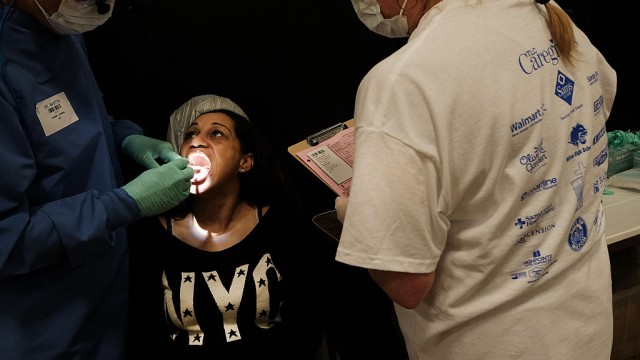
It is easy to view dental care as a luxury. Many people do. In a 2015 Federal Reserve Report on the Well-Being of U.S. Households, for example, 25 percent of those surveyed said that they had skipped a dental appointment in the preceding 12 months because they could not afford it—compared to 15 percent who had skipped a doctor’s appointment over the same time period for the same reason.
dental laser accessories
However, in fact, the impact of not accessing dental care can be great, including missed work or school, diminished social connections—even sub-optimal nutrition, since dental disease can hinder the ability to eat. Poor dental health increases the risk for diabetes, heart disease and poor birth outcomes.
In addition, there are many systemic conditions that have symptoms that first manifest in the mouth. These are among the reasons that Healthy People 2020—a report issued every decade by the Department of Health and Human Services released in December 2010—includes oral health as a leading health indicator for the first time.
In 2000, the first U.S. government assessment of Americans’ oral health was released—and it did not paint a pretty picture. The Surgeon General characterized dental and oral diseases as a “silent epidemic” among some population groups. Unfortunately, not much has improved since then.
dental laser accessories
A 2012 Senate Report found that 17 million low-income children had received no dental care in 2009; that one fourth of adults in the U.S. ages 65 and older had lost all of their teeth; and that low-income adults were almost twice as likely as higher-income adults to have gone without a dental checkup in the previous year.
In a study published last week, we developed a forecasting model to determine how demographic trends and recent health care policies—such as the Affordable Care Act (ACA)—will affect dental care use in the future. The model is based on historical data from 1996-2013 Medical Expenditure Panel Survey (MEPS), the most complete set of data on the cost and use of health care and health insurance coverage in the U.S.
First, the good news—for the nation’s health and pocketbook: our model indicates that visits for preventive dental care will increase in the future, while visits for dental treatment will decline. According to our forecast, Americans will make 304 million dental visits in 2017. That number will increase to 328 million to 334 million in 2026, depending on how many parents take up newly available dental coverage for their children. Almost 35 percent of people will have a visit for preventive care in 2017, with that percentage increasing to 37 to 39 percent in 2026. Ten percent of people will visit the dentist for treatment in 2017, with that percentage dropping to 9 percent in 2026.
The bottom line: more prevention and less treatment means significant savings for individuals and government—measured in both individual pain and suffering as well as dollars and cents.
Our forecasts also suggest that the medical and dental insurance reforms instituted under the ACA reinforce the historical upward trend in dental care use and the number of dental visits. In 2017, 43 percent of the population will use dental services, rising to 45 percent in 2026, without accounting for the ACA. This increase reflects an average annual growth rate of 0.5 percent, which is more than double the average annual rate of 0.2 percent during the prior two decades. After all provisions of the ACA are taken into account, the rate of dental care use rises to 47 percent.
The data also make clear that mandating pediatric coverage in all state Medicaid plans—as well as the ACA’s requirement that individual and small group insurance plans include pediatric oral health services for children up to age 19 as an essential health benefit—has and will increase demand for dental care among children. In 2017, approximately 51 percent of U.S. children will have accessed dental care. Our forecast shows that number increasing to more than 56 percent by 2026.
Among the bad news: adults will not enjoy that same increase. In fact, the gap between dental care utilization by children and adults is expected to widen. Though rates for adults will continue to rise through 2026, our model shows a modest increase that is not enough to keep the gap from expanding. While more than 56 percent of U.S. children will use dental care by 2026, less than 41 percent of U.S. adults will do so.
By increasing access to child dental benefits through the Medicaid program, the ACA took a significant step forward in making dental& care& available to underserved populations. However, the limitation of adult dental coverage to Medicaid expansion states and failure to add a dental benefit to Medicare was a lost opportunity to extend dental benefit coverage to a community in need.
dental laser accessories
Whatever changes to the ACA the next administration makes, we recommend expanding dental coverage to populations still without it. Such an expansion would likely result in projections that surpass those we have provided—with great potential to benefit the health of Americans.
Chad D. Meyerhoefer is an associate professor in the Department of Economics at Lehigh University. Irina Panovska is an assistant professor in the Department of Economics at Lehigh University. Richard J. Manski is a professor in and chair of the Department of Dental Public Health at the University of Maryland School of Dentistry. Their findings were published in an article, “Projections of Dental Care Use Through 2026: Preventive Care To Increase While Treatment Will Decline,” in the December 2016 issue of Health Affairs.

